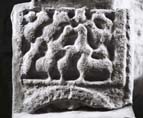Select a site alphabetically from the choices shown in the box below. Alternatively, browse sculptural examples using the Forward/Back buttons.
Chapters for this volume, along with copies of original in-text images, are available here.
Object type: Fragment of shaft [1]
Measurements: H. 29 cm (11.5 in); W. 35.5 > 35 cm (14 > 13.75 in); D. 12 cm (4.75 in)
Stone type: Greyish orange pink (5YR 7/2), moderately sorted, clast-supported, quartz sandstone. The sub-angular to sub-rounded clasts range from fine-grained (0.2 mm) to granular (2.5 mm), but are mostly medium- to coarse-grained in the range 0.4 to 0.6 mm. ?Pendle Grit Formation, Millstone Grit, Carboniferous
Plate numbers in printed volume: Ills. 494-5
Corpus volume reference: Vol 9 p. 191-2
(There may be more views or larger images available for this item. Click on the thumbnail image to view.)
A (broad): Parts of two panels are visible with a vertical cable-moulding border flanking them to the right. (i) The upper scene, with broad inner border to the right and a narrow bottom border still surviving, shows a flock of animals (probably sheep), carved with a strong sense of perspective. (ii) Below is an arch formed by pellets with flanking narrow borders; only a very small and unintelligible part of the scene within this arch survives.
B (narrow): Only an inner vertical border remains on this face.
C (broad) and D (narrow): Lost
Collingwood (1927a, fig. 92) and Potts (1982, 19) both saw this fragment as belonging to the same shaft as Halton 3 (Ills. 480–2). Its delicate lively carving, combined with a pelleted arched frame, is, however, perhaps closer to what survives of the style and organisation of Halton (St Wilfrid) 4 (Ills. 485–7).
Lang pointed out that there are twelve sheep represented and that they could therefore well symbolise the apostles in this context (Lang 1999, 279; id. 2000, 118). Particularly relevant to this interpretation is the 817–24 apse decoration by Pope Pascal at S. Prassede in Rome, in which apostles are represented as sheep (Durliat 1985, pl. 81; see also Bolgia 2006). As such, Paschal's work represents a Carolingian-period revival of an earlier theme which had appeared at Ravenna in S. Apollinare in Classe of 549 as well as in Rome at SS. Cosma e Damiano of 520–30 — and on the fifth-century Marseilles S. Victor altar slab (Hubert et al. 1969, pl. 15; Beckwith 1970, pls. 95, 103). Halton presumably reflects the same Carolingian-period revival. In their clustering the animals resemble the two sets of six sheep at S. Maria Maggiore, Rome, of 432–40 (Nees 2002, pl. 53).



